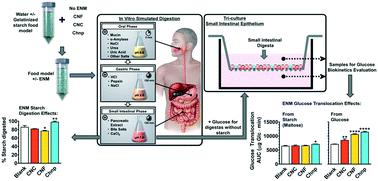当前位置:
X-MOL 学术
›
Environ. Sci.: Nano
›
论文详情
Our official English website, www.x-mol.net, welcomes your feedback! (Note: you will need to create a separate account there.)
Effects of ingested nanocellulose and nanochitosan materials on carbohydrate digestion and absorption in an in vitro small intestinal epithelium model
Environmental Science: Nano ( IF 7.3 ) Pub Date : 2021-07-20 , DOI: 10.1039/d1en00233c Zhongyuan Guo 1 , Glen M DeLoid 1 , Xiaoqiong Cao 1 , Dimitrios Bitounis 1 , Kaarunya Sampathkumar 2 , Kee Woei Ng 1, 2, 3, 4 , Say Chye Joachim Loo 1, 2 , Demokritou Philip 1, 2
Environmental Science: Nano ( IF 7.3 ) Pub Date : 2021-07-20 , DOI: 10.1039/d1en00233c Zhongyuan Guo 1 , Glen M DeLoid 1 , Xiaoqiong Cao 1 , Dimitrios Bitounis 1 , Kaarunya Sampathkumar 2 , Kee Woei Ng 1, 2, 3, 4 , Say Chye Joachim Loo 1, 2 , Demokritou Philip 1, 2
Affiliation

|
Nanoscale materials derived from natural biopolymers like cellulose and chitosan have many potentially useful agri-food and oral drug delivery applications. Because of their large and potentially bioactive surface areas and other unique physico-chemical properties, it is essential when evaluating their toxicological impact to assess potential effects on the digestion and absorption of co-ingested nutrients. Here, the effects of cellulose nanofibers (CNF), cellulose nanocrystals (CNC), and chitosan nanoparticles (Chnp) on the digestion and absorption of carbohydrates were studied. Starch digestion was assessed by measuring maltose released during simulated digestion of starch solutions. Glucose absorption was assessed by measuring translocation from the resulting digestas across an in vitro transwell tri-culture model of the small intestinal epithelium and calculating the area under the curve increase in absorbed glucose, analogous to the glycemic index. At 1% w/w, CNF and Chnp had small but significant effects (11% decrease and 14% increase, respectively) and CNC had no effect on starch hydrolysis during simulated digestion of a 1% w/w rice starch solution. In addition, at 2% w/w CNC had no effect on amylolysis in 1% solutions of either rice, corn, or wheat starch. Similarly, absorption of glucose from digestas of starch solutions (i.e., from maltose), was unaffected by 1% w/w CNF or CNC, but was slightly increased (10%, p < 0.05) by 1% Chnp, possibly due to the slightly higher maltose concentration in the Chnp-containing digestas. In contrast, all of the test materials caused sharp increases (∼1.2, 1.5, and 1.6 fold for CNC, CNF, and Chnp, respectively) in absorption of glucose from starch-free digestas spiked with free glucose at a concentration corresponding to complete hydrolysis of 1% w/w starch. The potential for ingested cellulose and chitosan nanomaterials to increase glucose absorption could have important health implications. Further studies are needed to elucidate the mechanisms underlying the observed increases and to evaluate the potential glycemic effects in an intact in vivo system.
中文翻译:

在体外小肠上皮模型中摄入的纳米纤维素和纳米壳聚糖材料对碳水化合物消化和吸收的影响
源自天然生物聚合物(如纤维素和壳聚糖)的纳米级材料具有许多潜在有用的农业食品和口服药物递送应用。由于它们巨大的潜在生物活性表面积和其他独特的物理化学特性,在评估它们的毒理学影响时,评估它们对共同摄入的营养物质的消化和吸收的潜在影响至关重要。在这里,研究了纤维素纳米纤维 (CNF)、纤维素纳米晶体 (CNC) 和壳聚糖纳米粒子 (Chnp) 对碳水化合物消化和吸收的影响。通过测量淀粉溶液模拟消化过程中释放的麦芽糖来评估淀粉消化。葡萄糖吸收通过测量从产生的食糜穿过体外的易位来评估小肠上皮的 transwell 三培养模型并计算吸收葡萄糖的曲线下面积增加,类似于血糖指数。在 1% w/w 时,CNF 和 Chnp 的影响很小但很显着(分别减少 11% 和增加 14%),并且 CNC 在 1% w/w 大米淀粉溶液的模拟消化过程中对淀粉水解没有影响。此外,2% w/w CNC 对 1% 大米、玉米或小麦淀粉溶液中的淀粉分解没有影响。同样,从淀粉溶液的食糜(即麦芽糖)中葡萄糖的吸收不受 1% w/w CNF 或 CNC 的影响,但略有增加(10%,p< 0.05) 1% Chnp,可能是由于含 Chnp 的食糜中麦芽糖浓度略高。相比之下,所有测试材料都导致从添加了相当于完全水解浓度的游离葡萄糖的无淀粉食糜中吸收葡萄糖的能力急剧增加(CNC、CNF 和 Chnp 分别为约 1.2、1.5 和 1.6 倍) 1% w/w 淀粉。摄入纤维素和壳聚糖纳米材料增加葡萄糖吸收的潜力可能对健康产生重要影响。需要进一步的研究来阐明观察到的增加的机制,并评估完整的体内系统中潜在的血糖影响。
更新日期:2021-07-28
中文翻译:

在体外小肠上皮模型中摄入的纳米纤维素和纳米壳聚糖材料对碳水化合物消化和吸收的影响
源自天然生物聚合物(如纤维素和壳聚糖)的纳米级材料具有许多潜在有用的农业食品和口服药物递送应用。由于它们巨大的潜在生物活性表面积和其他独特的物理化学特性,在评估它们的毒理学影响时,评估它们对共同摄入的营养物质的消化和吸收的潜在影响至关重要。在这里,研究了纤维素纳米纤维 (CNF)、纤维素纳米晶体 (CNC) 和壳聚糖纳米粒子 (Chnp) 对碳水化合物消化和吸收的影响。通过测量淀粉溶液模拟消化过程中释放的麦芽糖来评估淀粉消化。葡萄糖吸收通过测量从产生的食糜穿过体外的易位来评估小肠上皮的 transwell 三培养模型并计算吸收葡萄糖的曲线下面积增加,类似于血糖指数。在 1% w/w 时,CNF 和 Chnp 的影响很小但很显着(分别减少 11% 和增加 14%),并且 CNC 在 1% w/w 大米淀粉溶液的模拟消化过程中对淀粉水解没有影响。此外,2% w/w CNC 对 1% 大米、玉米或小麦淀粉溶液中的淀粉分解没有影响。同样,从淀粉溶液的食糜(即麦芽糖)中葡萄糖的吸收不受 1% w/w CNF 或 CNC 的影响,但略有增加(10%,p< 0.05) 1% Chnp,可能是由于含 Chnp 的食糜中麦芽糖浓度略高。相比之下,所有测试材料都导致从添加了相当于完全水解浓度的游离葡萄糖的无淀粉食糜中吸收葡萄糖的能力急剧增加(CNC、CNF 和 Chnp 分别为约 1.2、1.5 和 1.6 倍) 1% w/w 淀粉。摄入纤维素和壳聚糖纳米材料增加葡萄糖吸收的潜力可能对健康产生重要影响。需要进一步的研究来阐明观察到的增加的机制,并评估完整的体内系统中潜在的血糖影响。


























 京公网安备 11010802027423号
京公网安备 11010802027423号